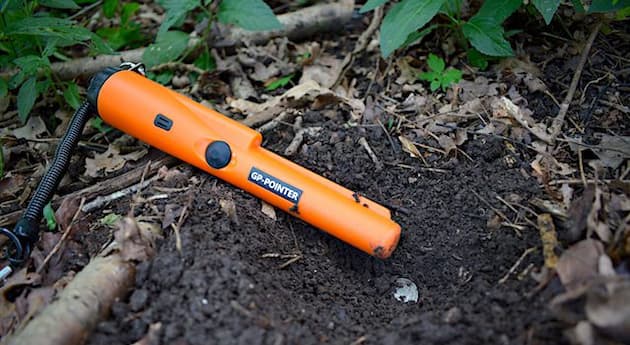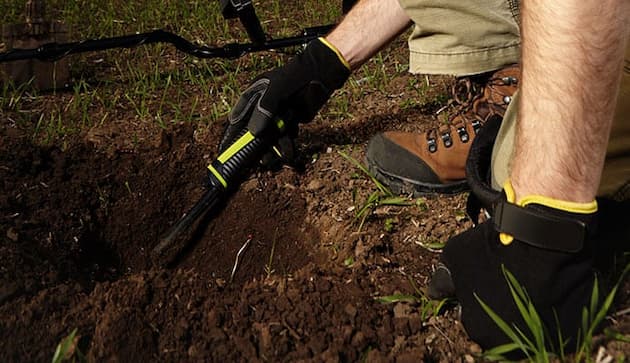Pinpointer Metal Detector Guide
By Steven Harrisson, August 27, 2021
If you’ve just begun searching for treasures, you may believe that you only need a metal detector and something to dig with. The truth is that you can find targets using a detector only, but a pinpointer can save you a lot of time and hassle. It’s a device, whether handheld or built into the metal detector, which allows you to hone in on your target. In both cases, the device will produce a sound whose frequency is relative to the signal the device is receiving from the object, allowing you to know how close it is.
Can You Metal Detect with a Pinpointer?

Pinpointers can supplement regular detectors, meaning that they can be used only when an object is already detected using a regular metal detector. Their purpose is to narrow down the area where a target is located, so you can easily find it. They operate using the same technologies regular metal detectors use but are much smaller and useful in different ways.
Benefits of Using a Metal Detecting Pinpointer
While regular metal detectors are used to search large areas in a relatively short amount of time, pinpointers are used to determine the exact location, depth and even size of an object. They are a small, lightweight, static metal detector that helps you precisely locate a target, dig smaller holes and results in a faster target recovery time.
Thanks to their handheld design and the small or rather focused field of detection, they can help you find out if you might have already dug it up. It’s easier to use a metal detecting pinpointer to look through a pile of dug up material rather than a bulky regular metal detector.
A pinpointer gold detector is a small investment that will pay off in the long run, especially through the additional targets you find. You can choose a pinpointer and make your metal detecting experience easier, more enjoyable and after all, more successful.
Often times with larger targets, and even with smaller ones, you may damage the object with your shovel because you don’t know how deep it is. A metal detecting pinpointer will prevent it from happening, so you can get any object in the same shape it was before you started digging.
How to Use a Metal Detecting Pinpointer

There are different types of pinpointers on the market, but essentially, they all serve the same purpose. If you have just bought your first pinpointer, you may be confused about how to use it effectively in the field. All you need to do is turn it on, scan and pint and recover your target. The operating instructions may vary slightly from one model to another; however, the following are the general guidelines to using a metal detecting pinpointer.
Find the location of the target with your regular metal detector. Once you’ve found it, begin digging small amounts of material with your digging tool carefully, so you won’t damage the object. Then turn on the metal detecting pinpointer, ground balance it and move it around until the sound coming from the device gets louder, repetitive or both, depending on your metal detecting pinpointer.
If you are operating it in a high-mineralised terrain, you can use the tip to dig through the dirt and find the target. Put the tip of the metal detecting pinpointer directly into the soil, sand or saltwater and press the ground balancing button. If the object is not in the dug-up material, then you can try using the device to locate the object in the bottom of the hole or maybe in its sidewalls. Hold the device vertically and side-scan by moving it left and right. Recover your target and power off the metal detecting pinpointer and put it back in its holster, pouch or pocket.
Then you can clean your target with dedicated cleaning tools to prevent any damage and inspect it thoroughly. Whether it’s a good object or a trash item, bag it, refill the hole and move on, searching for a new target.
If you forgot to pick up and pack your metal detecting pinpointer away, make sure to go back to the ground where you plugged the hole. If left on without use for about five minutes, your metal detecting pinpointer will start emitting a series of audible alerts. These alerts can be different for every model. Also, the time the device emits the lost alarm alerts before automatically powering off is different for every model. Usually, they last about 5 to 10 minutes, but some pinpointers can provide alerts for up to an hour. Once you’ve found it, power it off and turn it on again when needed.

Pinpointers are relatively easy to use, but when it comes to making adjustments, it may get a bit challenging because of the one-button operation. On most pinpointers, a single button is the same button for turning it on and off to settings adjustments and retune. If that’s the case with your metal detecting pinpointer, then you should know that a single press activates it, a quick press retunes or calibrates it and a long press activates the settings. With consecutive presses, you can select audio modes, sensitivity or vibration. The pinpointers that have adjustable sensitivity may offer 3 to 5 levels.